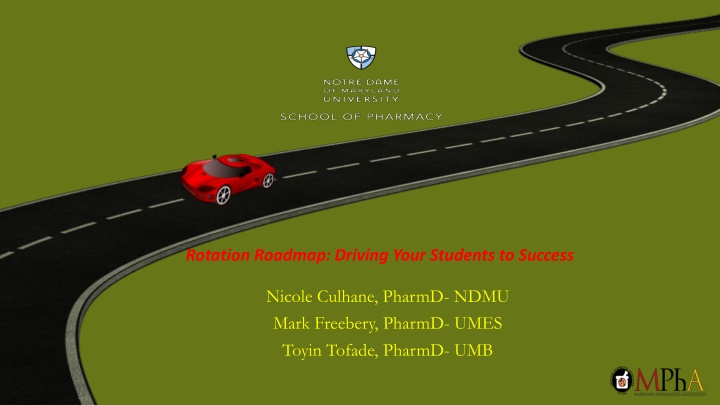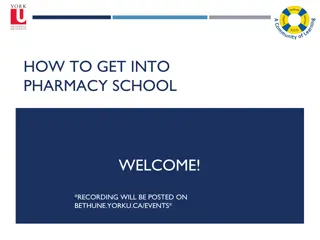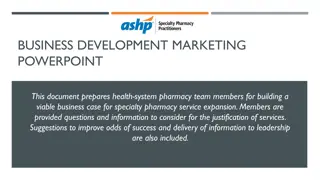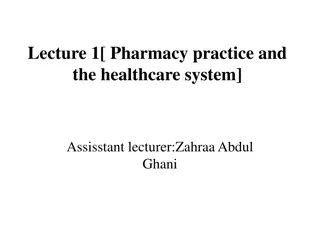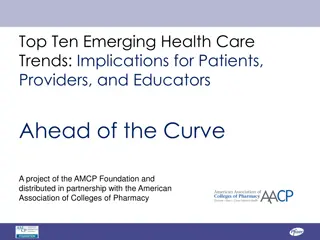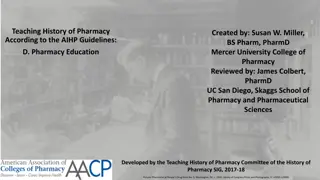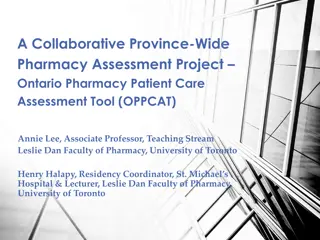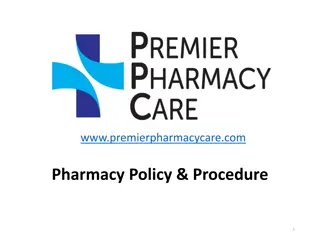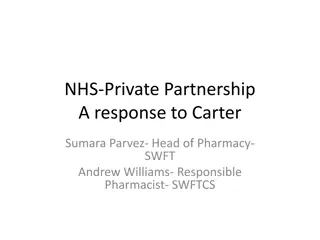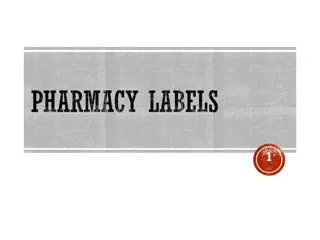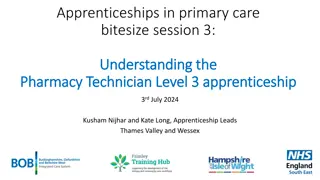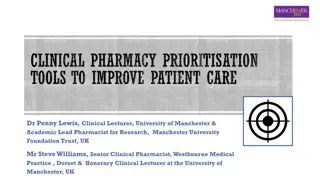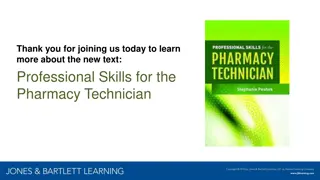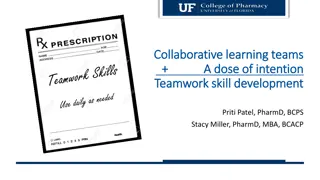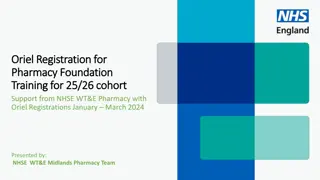Developing Effective Rotation Activities for Pharmacy Students
Explore strategies for creating valuable rotation experiences for pharmacy students. Learn to identify unique practices, evaluate student performance, provide feedback, and maximize student potential. Understand the importance of setting expectations, developing daily activities, and assigning projects that enhance learning. Improve the overall rotation experience by setting clear objectives and utilizing students efficiently to extend pharmacy practice.
Download Presentation

Please find below an Image/Link to download the presentation.
The content on the website is provided AS IS for your information and personal use only. It may not be sold, licensed, or shared on other websites without obtaining consent from the author.If you encounter any issues during the download, it is possible that the publisher has removed the file from their server.
You are allowed to download the files provided on this website for personal or commercial use, subject to the condition that they are used lawfully. All files are the property of their respective owners.
The content on the website is provided AS IS for your information and personal use only. It may not be sold, licensed, or shared on other websites without obtaining consent from the author.
E N D
Presentation Transcript
Rotation Roadmap: Driving Your Students to Success Nicole Culhane, PharmD- NDMU Mark Freebery, PharmD- UMES Toyin Tofade, PharmD- UMB
Objectives Identify unique practices at your site to create valuable rotation activities and experiences. Discuss how to evaluate your student s performance and effectively provide constructive feedback. Determine how to utilize rotation students more efficiently to extend your pharmacy practice.
Developing Rotation Activities Toyin Tofade and Mark Brueckl University of Maryland School of Pharmacy
Objectives Identify the workflow and activities for the practitioner Discuss how to present a road map for the specified rotation Utilize practices at your site to create valuable experiences List sample projects for the student to work on based on the rotation type
Why is this important? This helps set expectations for the rotation experience It helps provide a smooth transition from day to day Allows the student to clarify preconceived notions Prevents surprises later in the rotation Provides a road map of what the overall experience ought to be
Setting Expectations Keep in mind that you have been doing this for much longer than the student has You may need to repeat or clarify instructions They are new to your environment The student knows much less than you do about patient care or your sites practice Slow it down for them
Developing Rotation Activities Identify Daily Activities in Pharmacy Patient Counseling Patient Education Rounding Staffing Drug monitoring ADE reporting Dispensing Additional Services
Developing Rotation Activities Projects Case/Topic Discussion/Journal Scan Develop Patient-Focused Programs New Drug Update Additional Activities
Patient Counseling Prescription vs. OTC Set a goal to be achieved by the student Assign a specific time for patient counseling Place student in OTC aisle assisting patients MTM Step by step process See one, do one, teach one
Patient Education Device Training Blood Glucose Monitors Inhalers Smoking Cessation Otic/Ophthalmic Medications
Rounding Looking up the data Listening to the presentation Listening to the discussion by health care providers Listening to the patient Providing a recommendation Writing a note in the chart Reviewing lab data and interpreting them Looking up answers to follow up questions
Drug monitoring Pharmacokinetics TPN Narrow therapeutic drugs Sedation Pain drugs others
Additional Services Immunizations Blood Pressure Readings Refill Reminders Group Home/Assisted Living/LTC Outreach Durable Medical Equipment Compounding
Projects Case/Topic Discussion/Journal Scan Student prepares patient case - presents to pharmacy staff Include relevant articles Provide treatment/drug therapy recommendations Working on medication use evaluation projects Develop Patient-Focused Programs Immunization Awareness Disease Screenings
Additional Activities Counseling Tips Resource library for pharmacist use Marketing Student to develop marketing materials for pharmacy programs Adverse Drug Reaction Reporting Business/Management Discussion Drug Information Questions Student to respond to patient and/or practitioner questions
Additional Activities (contd) Healthcare Discussion Pharmacy s role in global health Pharmacy Law Review Community Presentations Student to give presentation to community group Pharmacy/Health-Related topic Workflow Evaluation Student reviews for efficiency, safety, etc.
Additional Services Once a month meetings with key committees P & T Medication Safety Mortality and morbidity conferences Grand rounds
Things to consider What are the activities you participate in every day? What other activities do other colleagues participate in that will be beneficial to the student? What background information is needed to be able to perform those duties flawlessly? Any reading materials to help provide better context for each of those activities? Review the school s syllabus and see which course will best suit your site.
Assemble a Calendar What will the student do mostly everyday What activities will need to be spread out Spread out the reading discussions to about 2-3 times a week Is there a project or projects that will benefit the site and student? How long will it take to collect data and complete that work?
Evaluating Student Performance and Providing Constructive Feedback Mark Freebery and William Harbester University of Maryland Eastern Shore School of Pharmacy
Objectives Discuss the difference between formative and summative evaluations. List the types of feedback and identify which one or combination is necessary for your students. Identify the methods of providing feedback. Discuss how providing constructive feedback can promote student success.
Set Rotation Expectations Discuss with student at the beginning of the rotation How will you be assessing their work/improvement Set goals and project expectations Be familiar with the school s evaluation tools How and when will feedback will be given
Feedback vs. Evaluation Feedback Evaluation Timing Immediate/ Timely Scheduled Setting Informal/ on-the-fly Formal/ Private Content Formative Summative Scope Specific Actions Collective Performance Purpose Improvement (skills/knowledge) Grading and Improvement
Types of Feedback Positive Not provided enough Involves pairing desired behavior with positive reinforcement Motivates individual for additional achievement Negative (or not so positive) Obtains less predictable results May stop behavior or outcome that has already occurred, but: Student may perform better Stop trying because feel they are being scrutinized
Types of Feedback Constructive Helps individuals understand their learning needs Balanced; contains positives and areas for improvement Most desired, but most difficult No Feedback (Withholding) Worst; most common Students dislike most Least motivating response Leaves individuals blindsided
Feedback Methods Sandwich Method
Feedback Methods W3 Method What Went Well? You communicate clearly and in a manner that patients can understand, well done. What Didn t Go Well? However, I noticed that the information you recorded in the chart was very extensive. What Could We Do Differently Next Time? Be sure to document what is relevant and pertinent to developing a treatment plan, and omit details that are not patient related.
Providing Effective Feedback Inform students at start of the learning experience to expect feedback routinely Conversation should take place in a relaxed, private area Engage in a two-way conversation with student Be descriptive, not evaluative (i.e. what did you observe about the student s performance that requires feedback) Focus on behavior that can be changed, not personal traits of the individual Observe an activity more than once before offering feedback.
Providing Effective Feedback Well-timed (offer feedback as soon as event has taken place) Get input from other preceptors/colleagues Limit feedback to one or two items Tied to specific goals Related to goals and objectives for the experience Ask student to offer own thoughts and plans for improvement Clear, specific and related to the facts
Why Provide Feedback Improving self awareness Enhancing self esteem Raising morale Encouraging people to want to learn Offering reassurance Motivation Improving individual performance
Final Thought Feedback matters. It really matters. Good feedback is like a road map, a site map, an energy drink, a bungee jump, or meditative moment for your brain. It makes you smarter, more focused, more confident, and more capable of doing your best work. -Jill Geisler Poynter Institute
Utilizing Students to Extend Your Pharmacy Practice Nicole Culhane Notre Dame of Maryland University School of Pharmacy
Objectives List ways for balancing patient care and precepting responsibilities Discuss strategies for integrating students into the workplace Develop a potential plan for integrating students into your daily pharmacy practice
Integrating students into your pharmacy practice Identify points in the workflow that the student can easily step into Provide readings or prior student experiences for student to easily learn about your practice followed by a short discussion
Integrating students into your pharmacy practice Cross-train other pharmacists/technicians on staff to help teach the student Discuss with the student regarding how they feel they can contribute to your practice based on past and present experiences Discuss areas for student involvement Operational Managerial Direct patient care
Integrating students into your pharmacy practice Identify areas where students can have autonomy and function as the pharmacist with proper oversight Medication reconciliation Rounding Immunizations Medication therapy management Tell me and I'll forget; show me and I may Tell me and I'll forget; show me and I may remember; involve me and I'll understand. remember; involve me and I'll understand. - Chinese Proverb
Integrating students into your pharmacy practice Allow the day to day operations to establish the curriculum Student pharmacists can help to improve your practice and be the impetus to expand an existing service or start a new service Medication safety Patient satisfaction Research/data collection
Encouraging student responsibility and autonomy Setting the foundation/groundwork early orientation Discussing student expectations and assigning areas where students are fully accountable Making sure they understand their level of responsibility and accountability
Encouraging student responsibility and autonomy Establish a culture of follow-up; they are the go to people with certain issues about patients Set weekly goals Give students a list of questions for every patient and report back to you Determine a point at which the student meets competency and can be autonomous Continue to add on additional competencies weekly
Encouraging student responsibility and autonomy Presentations to staff, medical residents, nurses Assigning students reading and presentations on literature you have not had time to read Assigning specific tasks that occur commonly that become the students' responsibility Focus on particular medication conditions (diabetes, COPD, heart failure, antibiotics)
Incorporating Students Into Your Workflow: Health-System In-patient Rounds Assign students their own patients that they are responsible for Gathering patient data Medication history Laboratory data Pre-rounding with the students to assure adequate preparation to answer specific questions/issues that arise Hide in the background or go to nursing station so students feel they are responsible Encourage students to spend as much time on the unit as possible so they are available when questions arise
Incorporating Students Into Your Workflow: Health-System Rounds (con t) Pair students with patients covered by medical students if possible Encourage peer mentorship in areas of expertise Utilize a hierarchy of teaching (IPPE/APPE) Don t be too quick to jump in and save the student on rounds Decide on number and complexity of patients based on student
Incorporating Students Into Your Workflow: Health-System Pharmacy to dose protocols Formulary Interchange IV to PO switches Renal dosing Vancomycin dosing
Incorporating Students Into Your Workflow: Community Doctor calls Insurance calls/prior authorizations Immunizations OTC consults Medication therapy management Medication counseling Patient education Drug information questions
Conclusions Student pharmacists CAN be integrated into busy patient care practices with some thought and prior planning Invest in the time upfront and you WILL get a ROI in the long run Be flexible and take the time necessary to provide proper orientation Explain your practice and rotation expectations
